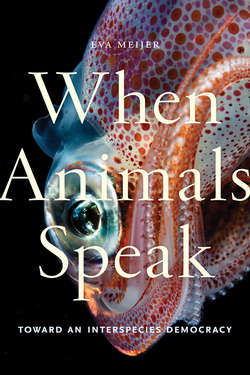When Animals Speak

Реклама. ООО «ЛитРес», ИНН: 7719571260.
Оглавление
Eva Meijer. When Animals Speak
When Animals Speak. Toward an Interspecies Democracy
Contents
Introduction
From the Political Animal to Political Animal Voices
Animal Languages
Theorizing from the Ground Up: A Note on Method
Political Animal Voices: A Brief Summary
1. The Animal, What a Word! Human Language and Non-Human Animals
Human Language and the Animal
Language and World
The Animal, What a Word! “Animal” and Animals
Speaking Back
Rethinking Language with Other Animals
2. Animal Languages
From Human Language to Animal Language Games. Studying Human Language in Other Animals
Language as Language Games
Parrots and Mimicry
Alarm Calls: From Communication to Language
Grammar
Meta-Communication: Play and Greeting
From Thinking about to Thinking with Other Animals
3. From Animal Languages to Interspecies Worlds
Learning to Read the Darkness: On the Relation between Language and World
Speaking Bodies
Understanding Other Animals
Living with Other Animals
Speaking to or with Dogs
Multispecies Households: Material Interventions and Fostering Non-Human Animal Agency
Developing New Relations with Other Animals
Case Study 1. Stray Philosophy. Dog-Human Observations on Language, Freedom, and Politics
Language and Habits
Words and Bodies
New Languages and Habits
Learning to Walk on the Lead
Discipline and Deliberation
Stray Politics
A Stray Dog from Romania
From Micro-Practices to Macro-Agency
Conclusion
4. Animal Politics. Justice, Power, and Political Animal Agency
Justice for Animals
Problems with Traditional Animal Rights Theories: Negative Rights and the Risk of Anthropocentrism
Anthropocentrism and the Links between Epistemic and Institutional Forms of Violence. Different Forms of Violence
Biopolitics and the Intersections of Epistemic and Institutional Violence
Political Non-Human Animal Agency
Redefining Relations with Other Animals
5. Animals and the State. Citizenship, Sovereignty, and Reformulating Politics
Animal Citizens
Challenges for the Citizenship Approach
Non-Human Animal Sovereignty
Sovereignty before Politics
Starting Points for Change: Rights as Tools, and Challenging Boundaries
Labor Rights
Habitat Rights and Territorial Rights
Urban Animals
Political Concepts as Starting Points for Change
6. Worm Politics
Small Agencies
Worm Power and Knowledge
Justice for Worms. From Sentience to Relations
Keep Your Ear to the Ground: Listening to Our Earthworm Neighbors
Respect and Response
Case Study 2. Goose Politics. Resistance, Deliberation, and the Politics of Space
Goose Politics
Goose-Human Communication
Foot Voting, Occupation, Squatting, and Deliberation. Political Goose-Human Interaction
Goose-Human Deliberation
The Politics of Space
New Pathways
7. Animal Activism and Interspecies Change
Non-Human Animal Resistance and Interspecies Civil Disobedience. Non-Human Animal Resistance
From Animal Resistance to Interspecies Disobedience
New Directions for Animal Activism: Connections between Social Movements, Speaking for or with Other Animals, and Assisting Other Animals
Speaking for or with Other Animals
Assisting Other Animals
From Animals as Actors of Change to Interspecies Communities: Stray Dog Agency and Animal Activism
8. Animal Democracy and the Challenges of Political Participation
Political Participation
The Borders of the Democratic Community
Moving towards Interspecies Democracies
Material Interaction with Seagulls
Greeting as a Political Ritual
Conclusion
9. Deliberating Animals. From Multispecies Dialogues to Interspecies Deliberation
Non-Human Animal Agency and Interspecies Dialogues
Deliberation and Interspecies Political Communication
Democratic Inclusion and Forms of Speech
Embodied Political Communication
Political Interspecies Communication
Time: From Completed Conversations to Ongoing Processes of Deliberation
Space: Meeting Other Animals on Their Ground
Physicality: Bodies, Objects, and Material Deliberations
Relations: Taking into Account the Context of Deliberation
Interspecies Deliberation: A Systemic View
A Systemic Perspective on Goose-Human Deliberations
The Importance of Beginning Now
Conclusion. Thinking with Animals
Writing with Animals
Directions for Further Research
Acknowledgments
Notes. Introduction
Chapter 1. The Animal, What a Word!
Chapter 2. Animal Languages
Chapter 3. From Animal Languages to Interspecies Worlds
Case Study 1. Stray Philosophy
Chapter 4. Animal Politics
Chapter 5. Animals and the State
Chapter 6. Worm Politics
Case Study 2. Goose Politics
Chapter 7. Animal Activism and Interspecies Change
Chapter 8. Animal Democracy and the Challenges of Political Participation
Chapter 9. Deliberating Animals
Conclusion. Thinking with Animals
Works Cited
Index
About the Author
Отрывок из книги
Animals in Context
General Editor: Colin Jerolmack
.....
Because he only focuses on the negative and does not build a positive framework in which we can rethink multispecies relations, Derrida also fails to offer a starting point for rethinking the meaning of concepts with other animals, which is necessary if we want to move beyond anthropocentrism. This runs the risk of reinforcing a view of other animals as silent, which is ontologically problematic and has consequences for the social and political position of other animals. Furthermore, it does not take into account that other animals do speak, whether or not humans acknowledge the fact.
Derrida’s cat sits in the bathroom and looks at him. “I must immediately make it clear,” he writes, “the cat I am talking about is a real cat, truly, believe me, a little cat. It isn’t the figure of a cat. It doesn’t silently enter the bedroom as an allegory for all the cats on the earth, the felines that traverse our myths and religions, literature and fables” (2008, 6). This real cat’s gaze makes him uncomfortable, which is the starting point for his reflections. The cat sits there while Derrida writes about human and non-human animals, about the human and the animal—he returns to her every now and then.
.....